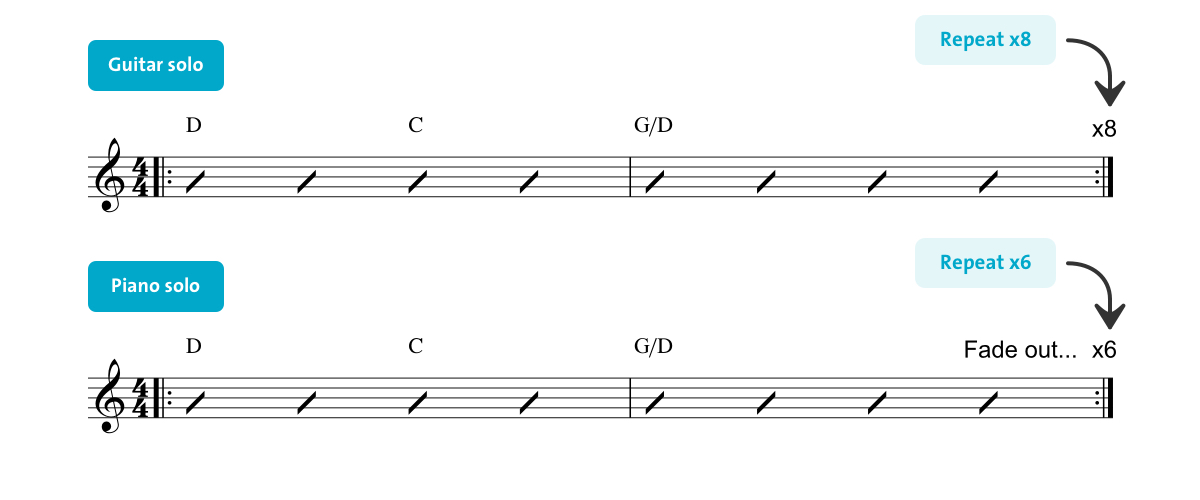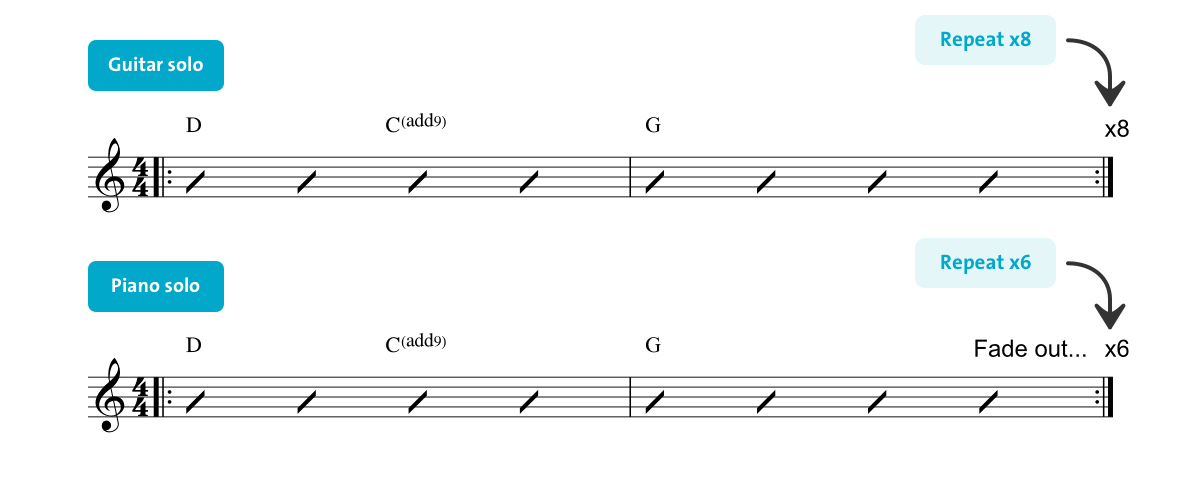Welcome dear piano players to another edition of our Songs Explained series. We’ve got a classic gem for you. “Sweet Home Alabama” by Lynyrd Skynyrd is a great example of a three-chord song. In this article you’ll find all the chords, note transcriptions and lyrics to help you out during your journey to the South.
In this blog:
Check out “Sweet Home Alabama” for guitar chords and tabs or read everything there is to know about “Sweet Home Alabama” for ukulele in this article.
‘Sweet Home Alabama’ for piano
This blog post is dedicated to explaining all the ins and outs of Lynyrd Skynyrd’s “Sweet Home Alabama” for piano. Use the table of contents to select your skill level; we’ll guide you to the part of this blog post that focuses on your preference. As always, we’ve got the chords, the lyrics and everything else that will help you master “Sweet Home Alabama” in no time.
After explaining the practical part of how to play the song, we’ll dive deeper into the theoretical matter. At the very end, we’ve also listed some anecdotes concerning this track. This way you can keep the conversation going during awkward Zoom parties by sharing some fun facts about the triple “Boo,” and what the band means by the following line: “Does your conscience bother you?” Enjoy!
Song structure
First, let’s take a look at the structure of “Sweet home Alabama.” As you can see in the figures below, the track consists of 14 parts. Yeah, we know, that sounds like you have a lot to learn. Nobody said it was going to be easy! But we’ve got some good news too. First let’s take a look at the actual structure.

Figure 1: Song structure of Sweet Home Alabama.
Main chord progression D-C-G
Don’t get discouraged yet. The song structure of this Lynyrd Skynyrd classic may be long, but you’ll see that everything involves just three chords. “Only three chords?!” That’s right! Lynyrd Skynyrd uses a very basic chord progression, and by doing so the band creates a lot of room for improvisation. Check out the chord sequence below.

Figure 2: Main chord sequence.
So, for the intro, all interludes, all verses and all solos, you need just these three chords. In the chorus part, something interesting happens: The band extends the harmonic aspect of the chord progression. How? Just read on and we’ll tell you. Here’s a heads-up though: From here on we’re splitting the article up in two parts. The first focuses on beginners, the second is for advanced pianists.
Beginner
In this part:
- Learn how to sound like this (video)
- Easy piano chords
- Chorus chord progression
- Chords with lyrics
- Back to top
Learn how to sound like this (video)
Hey there! If you’re a beginner who just started to play piano, and you’re eager to learn how to play “Sweet Home Alabama,” this is the place to be. In this part we’re going to walk you through the song “Sweet Home Alabama” by Lynyrd Skynyrd.
Easy piano chords
Playing this track will help you master some basic chords, improve your skills, and skyrocket your feeling for rhythm. Let’s get started, shall we? Just take a closer look at the intro, verses, interludes and solos. All these parts are based on the chord sequence D, C, G. The only difference is the amount of times these chords are repeated. Before we continue check out the chord diagrams below. To help you out with the duration of the song parts, we wrote down how many times you have to play each part.

Figure 3: D chord, C chord, G/D chord.
As piano players, we’re trying to make the chord voicings flow smoothly from one chord to the next. That’s why for the G chord we use the second inversion.
Here is the chord progression for the intro:
Here is the chord progression for verse:
Here is the chord progression for the interlude:
Here is the chord progression for both solos:
This all looks pretty doable, doesn’t it? That’s what we thought.
Chorus chord progression
Now let’s take a closer look at the chorus. It’s still based on our familiar chords from the picture above, but it has different variations at the end of the sequence.

Figure 7: D chord, C chord, G/C chord, C/E chord, F/C chord.
As you can see, the chorus contains an F chord as an extension of the three-chord progression. For G and F we use the second inversions. When playing the C chord, we use the first inversion. All these inversions contribute to creating a smooth flow of sound that gives this track its character.
Here is the chord progression of the chorus:
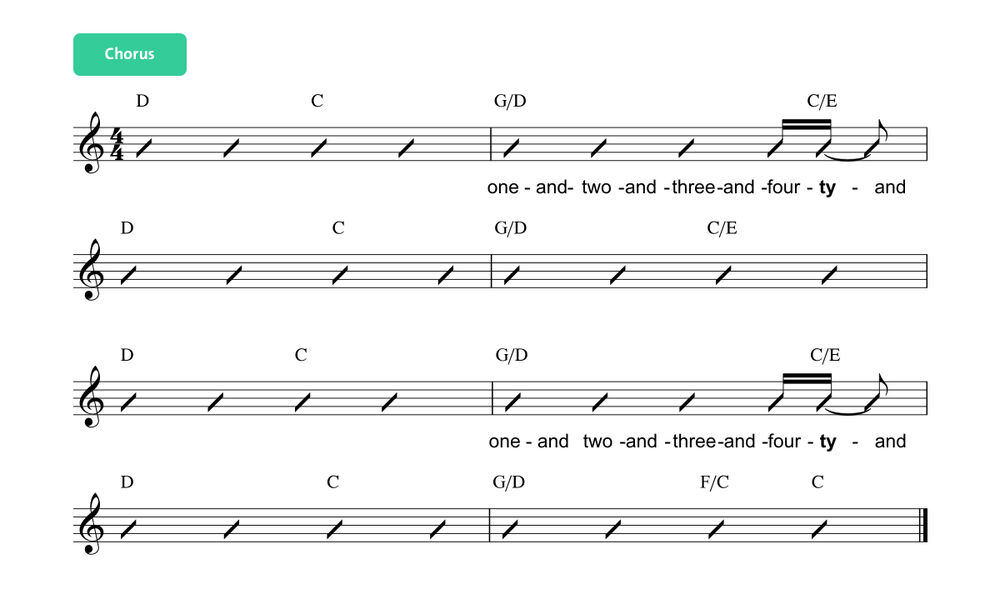
Figure 8: Piano chorus.
Take a closer look at the end of the first and third lines. The C/E chord comes at the end of the bar as a syncopated accent. To help you time this syncopated C, we put a metric pulse below. On the fourth beat we put the word “Fourty” instead of “Four.” It’s not a typo! This syllable “-ty” will help you to play the C/E chord at the right moment.
Chords with lyrics
That’s all folks. Now it’s your turn to play the entire song. Below, you’ll find the song structure of “Sweet home Alabama” with lyrics and chords. Enjoy!
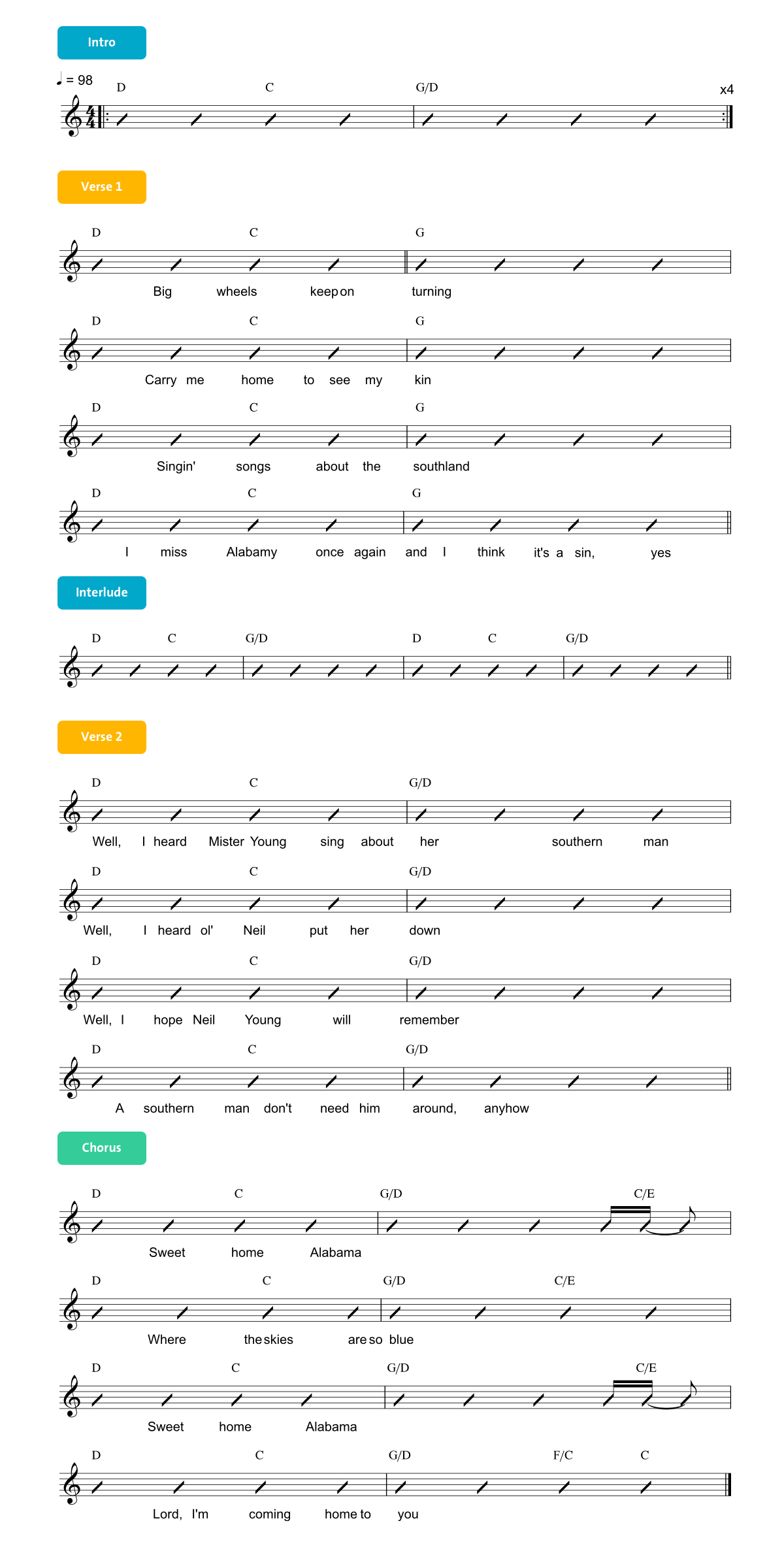
Figure 9: Piano chord sheet and lyrics.
Intermediate & pro
In this part:
- Learn how to sound like this (video)
- Advanced piano chords
- Chorus chords and tabs
- Chord overview with lyrics
- Back to top
Learn how to sound like this (video)
Welcome to the advanced level for piano of the “Sweet Home Alabama.” Here, we’re going to expand our chord voicings by playing bass notes in the low octave in the left hand. By doing this, we’ll always have a root note in the bass, which is very helpful for hearing a clear harmony. Especially if you play inversions in your right hand.
Advanced piano chords
Let’s start with the following parts: intro, verses, interludes and solos. All these parts are based on one sequence: D, C, G. To be more precise: D, Cadd9 and G. The only difference is how many times this chord sequence is repeated. To make it easier, we’ve mapped it out in Figure 4 below. First, check out the chord diagrams though.

Figure 10: D chord, Cadd9 chord and G chord.
As piano players we’re trying to make the chord voicings flow smoothly from one chord to the next. That’s why for the G chord we use the second inversion of that chord in the right hand (d – g – b notes), while playing a root note (g) in the bass with the left hand.
Here is the chord progression for the intro:
Here is the chord progression for the verse:
Here is the chord progression for the interlude:
Here is the chord progression for both guitar and piano solos:
As you can see, all these parts consist of the same chord progression. Here is the example of how we can play these parts on piano:

Figure 15: Piano example of chord progression.
It’s interesting to mention one thing about the second bar: In the right hand we keep playing the second inversion of G — G/D. In the left hand we play the root note — G. Both hands together play the G chord.
Chorus chords and tabs
Now it’s time to look at the sequence of the chorus. If you remember, this is the only part where the chord progression is a bit different than the rest of the song. It’s still based on the original chord sequence, but it has different variations at the end.

Figure 16: Piano D chord, C(add9) chord, G chord, C chord, F chord, C/E chord.
As you can see, the chorus contains an F chord as an extension to our three-chord progression. For the G and the F chord, we use the second inversion. For the C chord, we also use the first inversion. All these inversions help create a smooth flow of voicings.
Here is the chord progression for the chorus:

Figure 17: Piano chorus.
Take a closer look at the end of the first and third line. The C/E chord comes at the end of the bar as a syncopated accent. To help you play this syncopated C at the right moment, we’ve put a metric pulse below. For the fourth beat we’ve added the word “Fourty” instead of “Four.” It’s not a typo! This syllable, “-ty,” will help you to time the C/E correctly.
Here is the example of how we can play these parts on piano:

Figure 18: Piano example of chord progression.
It’s interesting to mention one thing about every second bar of each line: In the right hand we keep playing the inversions G/D, C/E and F/C, while in the left hand we play the root notes for these chords: G, C, F. Therefore, all these chords are in fact a G, a C and an F. Cool huh?
Chord overview with lyrics

Figure 19: Chord sheet with lyrics.
You’ve just learnt how to play all parts of the song “Sweet home Alabama” by Lynyrd Skynyrd. Now open up that piano, and play the whole song. Enjoy!
Music theorie: solos
Are you still hungry to learn more? That’s great! So, you’re pretty interested in boosting those piano skills. Good for you. In this section, you’ll learn all about soloing on “Sweet Home Alabama.”
At this moment, you’ve practiced all chords for this song, and you know all the parts of its structure. What more could you ask for? Well, you do hear a piano solo in the track, right? So, how about we tell you how to improvise over this chord progression? That way you can try out some fun melodies on top of the basic chords. To be able to improvise you need to know a bit of music theory. So, let’s dive into that right now!
As we already explained, the harmonic core of this song is formed by just three chords. This sequence is repeated over and over again. So, by playing the D chord, C chord, and G chord Lynyrd Skynyrd lay down a harmonic highway on top of which you can drive as fast, slow and freely as you want. There’s only one catch though: You need to know where this highway is. We’ll show you.

Figure 20: Main chord progression Sweet Home Alabama
Both the guitar and the piano are soloing over these chord changes that we just dubbed the highway. All these three chords — D, C, G — belong to the G major family. This means that the G major scale can cover all these chords. So, there you have it, the G major scale is your solo highway.
First of all, let’s have a look at the G major scale and the chord buildup:
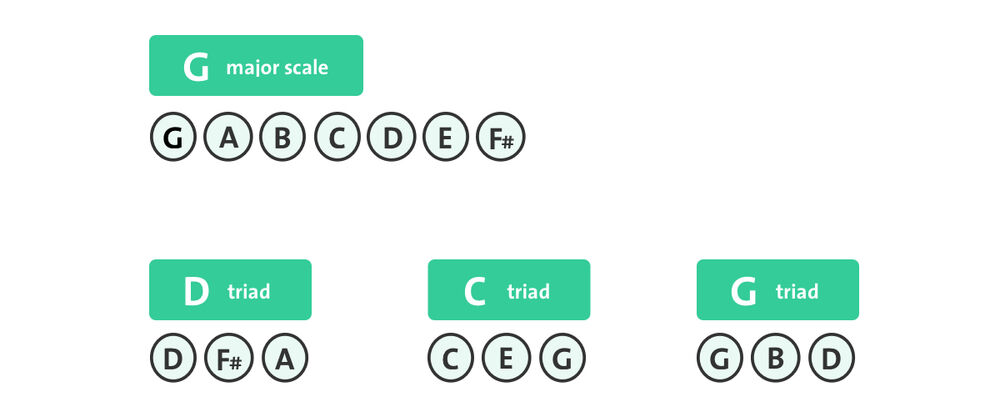
Figure 21: G major scale & chords.
As you can see, all notes of the D, C and G chords are from the G major scale. So, play the G major scale all over the keyboard and listen to which combinations sound nice and cool.
If you want to sound more bluesy, then here is another route you can take. Let’s say this is an alternative highway with the same benefits. We call it the E minor pentatonic scale. The E minor pentatonic has five notes: E – G – A – B – D. As you can see, these notes are from the G major scale. To make it even more bluesy, let’s add a “blue” note, which is A# (or Bb). So, the E minor pentatonic with blue note gives us the following scale: E – G – A – A# – B – D.
Summing it up, to improvise on “Sweet Home Alabama” you can use the:
- G major scale.
- E minor pentatonic.
- E minor pentatonic with “blue” note.
The E minor pentatonic adds more bluesy vibes to your sound, while the G major scale characterizes the key center of this song. Don’t take our word for it, try it out!
Fun facts about Sweet Home Alabama
Let’s make one thing very clear: Lynyrd Skynyrd is not from Alabama. Ed King, Gary Rossington, Ronnie van Zant, Allen Collins, Larry Junstrom and Bob Burns are originally from Jacksonville, Florida. Well, actually Ed King was from California, but still, that’s not Alabama. Yeah, mind blowing, right? We know. The song itself came into existence when guitarist Rossington was playing the intro riff while waiting for his bandmates to come to rehearsal. Ronnie van Zant couldn’t get enough and wrote the lyrics in a blink of an eye.
There’s a lot of speculation going on about the lyrics of “Sweet Home Alabama.” For example, Van Zant writes about Watergate, and the governor of Birmingham. Check out the third verse below.
In Birmingham, they love the governor (boo boo boo)
Now we all did what we could do
Now Watergate does not bother me
Does your conscience bother you?
Tell the truth
The governor to which the band refers is George Wallace, who was pro segregation. Some, those who don’t pick up the backing vocals singing “Boo, boo, boo!”, interpret the lyrics as racist. Although, in multiple interviews Van Zant has assured his audience that this was not the case. He often pointed out that the lyrics are meant to be interpreted as the voice of the Southern man, as an individual saying to the rest of America that he does not want to be judged by the actions of one man like Wallace.
There’s also the reference to the Watergate scandal, the one that cost Nixon his job. Again, Van Zant has said many times that this should be understood as the Southerner telling the Northerners that he doesn’t judge them by what their leader has done in Washington.
Whatever the true meaning of the lyrics may be, we can say one thing for sure: They have triggered a lot of people to analyze them. So this is the perfect conversation starter during your awkward Zoom party. You never know how where it will lead you, but it’s going to be interesting.
Happy jamming!
By Kirill Dumchenko and Teo Lazarov.




